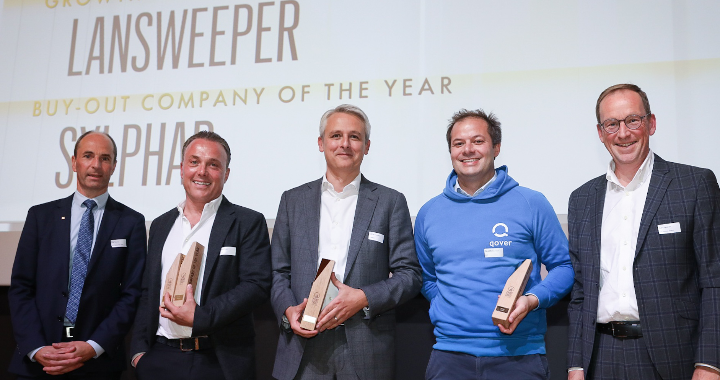On 12 October, our bank and the Belgian Venture Capital & Private Equity Association put the winning companies in the spotlight. With the support of Private Equity, all three completed a remarkable growth track.

The winners of the 2022 Private Equity Awards have been announced. It was the fifth time that BNP Paribas Fortis organised this event together with the Belgian Venture Capital & Private Equity Association (BVA). In addition to rewarding Belgian growth companies, this is also a good opportunity to highlight the added value of venture capital for start-up, fast-growing and mature companies.
And the winners are...
The three winners were selected from nine nominees in three categories: Venture capital, Growth, and Buy-out company of the year.
Qover was voted 'Venture Company of the Year'. This award was created for young companies that develop and market an innovative product or service with the support of a venture capital investor.
Qover enables any digital company to embed insurance in its value proposition. The company has built a tech platform that can launch any insurance product in any market, language and currency in a matter of days. The company is ready to scale up internationally and was praised for its innovative and disruptive business model.
Lansweeper was named 'Growth Company of the Year'. This category is for companies that have significantly expanded their activities through organic growth or acquisitions. They bring a financial partner on board who does not want control.
Lansweeper is an IT Asset Management platform provider that helps companies better understand, protect, and centrally manage their IT devices and network. The company has developed a software platform that can be used to create an inventory of all types of technology assets, installed software, and users. Besides setting an excellent financial track record, the company succeeded in gaining a solid foothold internationally.
Sylphar was the winner in the 'Buy-out Company of the Year' category. These are companies that achieve growth through involved management with the backing of a private equity investor with a controlling interest.
Sylphar develops and packages innovative and consumer-friendly OTC products worldwide. OTC products are medicines that are sold directly to the consumer without requirinng a doctor's prescription. Examples include tooth whitening products and skin, hair and body care products. Their spectacular digital transformation of the sales process, strong international expansion, and rapid product development were decisive factors.
"As a financial instrument, private equity is perfectly suited for boosting innovation and sustainable growth. The three winners have all proven this", says Raf Moons, Head of BNP Paribas Fortis Private Equity.
Find out more about Private Equity at BNP Paribas Fortis.
Source: press release
22.09.2022
Who will win a Private Equity Award this year?
The Private Equity Awards will be presented on 12 October 2022. We are organising this event for the fifth time, together with the Belgian Venture Capital & Private Equity Association (BVA). Check out this year’s nine nominees.
The Private Equity Awards reward Belgian companies that have received support from a private equity or venture capital investor for their growth and development. This is the fifth time that the Belgian Venture Capital & Private Equity Association (BVA) and BNP Paribas Fortis are organising this prestigious award ceremony.
The nine finalists were nominated based on criteria such as sustainable growth, authentic leadership, and active ownership. They are divided into three award categories: Venture capital, Growth, and Buy-out company of the year.
Venture company of the year:
- Aerospacelab
Aerospacelab is an innovative scale-up specialising in satellite platforms and information obtained from geospatial technology. The company designs, manufactures and operates a constellation of satellites for remote sensing, collecting useful information. - Precirix
Precirix is a biopharmaceutical company and a spin-off of the VUB. It is dedicated to extending and improving the lives of cancer patients by designing and developing precision radiopharmaceuticals. - Qover
Qover enables any digital company to embed insurance in its value proposition. The company has built a tech platform that can launch any insurance product in any market, language and currency in days.
Growth company of the year:
- Efficy
Efficy has developed a complete and highly customisable SaaS (Software as a Service) CRM (Customer Relationship Management) solution. The company wants to become five times bigger, increasing its market share to 5% of the independent CRM market in Europe, within five years. - Fedrus International
Fedrus International is an international building materials group that manufactures and distributes roof and façade materials and services with a focus on EPDM rubber and zinc. The company wants to become the preferred partner of building professionals, with high quality standards and a great sense of innovation. - Lansweeper
Lansweeper is an IT Asset Management platform provider that helps companies better understand, protect, and centrally manage their IT devices and network. The company has developed a software platform that can be used to create an inventory of all types of technology assets, installed software and users.
Buy-out company of the year:
- Baobab Collection
Baobab Collection sells diffusers and candles made from hand-blown glass or metal clad with precious leather. The Belgian brand remains true to its values of craftsmanship and excellence by supporting European expertise and craftsmen. - Sylphar
Sylphar develops and markets innovative and consumer-friendly OTC products worldwide. OTC products are medicines that are sold directly to the consumer without requiring a doctor's prescription. Examples include tooth whitening products and skin, hair and body care products.
- House of HR
House of HR is a leading European HR service provider focusing on Specialised Talent Solutions and Engineering & Consulting. Their goal is to connect people’s talents and dreams with successful companies.
Drive innovation and sustainable growth
"Private equity is a financial instrument that is perfectly suited to boost innovation and sustainable growth. The result is strong growth. But private equity involves after all so much more than just raising capital. Venture capital investors also share their knowledge and network, opening many doors. All the nominees have a solid track record and are all in with a chance to win. I am very curious to see which companies will take home an award", says Raf Moons, Head of BNP Paribas Fortis Private Equity.
Find out more about Private Equity at BNP Paribas Fortis.
Source: Press release BVA
09.05.2016
Private equity: a versatile form of financing
Private equity can also be a convenient way for SMEs to strengthen their equity and finance their further growth. But how do you attract private equity investors? And how do they operate?

Private equity can refer to many things. Which investment techniques are involved in private equity and in which cases are they used?
Private equity
Private equity is an instrument used by FPE to acquire an equity interest in a company, either alone or together with other investors. This does not involve a passive investment, but active share ownership: the aim is to engage in a partnership in the medium or long term. In concrete terms, this means that FPE is represented on the Board of Directors as a minority shareholder and in that capacity provides strategic and financial guidance and/or further professionalization of the company.
After a few years, FPE will withdraw from the company again. How this happens exactly is decided in consultation with the co-shareholder(s). They can buy the interest from FPE, but FPE may also sell it to another private equity investor or industrial player.
A company may decide to attract capital for various reasons. A common reason is that the company seeks to finance growth by increasing its activities, internationalising or acquiring other companies. The advantage is that no new private funds or excessive leverage are necessary. Other options are a business transfer or a (partial) buyout of family or less active shareholders.
Venture capital
Venture capital, also referred to as start-up capital, is a form of private equity used to finance early-stage, high-tech companies. These are mainly innovative start-up companies with promising growth prospects. FPE mainly provides venture capital through investments in university venture capital funds.
Mezzanine financing
Mezzanine financing is a long-term subordinated loan for which the company is not required to provide any interim repayments, but makes one lump-sum repayment at the end ('bullet'). These factors mean that the risks of mezzanine financing are higher, which makes it more expensive than a conventional loan with a shorter term, a repayment schedule and securities.
The company does have to generate sufficient returns and liquidity in order to bear the interest charges. The total payment usually consists of a combination of the following elements:
- Cash interest: Interest that is paid at regular intervals during the term.
- 'Payment in kind' (PIK) interest: Capitalised interest that is not paid in cash during the term, but is added to the payable capital and repaid along with the principal.
- Warrant: An instrument that entitles the provider of mezzanine financing to acquire a small percentage of the share capital later. This allows the provider to enjoy a variable payment too.
The exact relationship between these elements depends on the type of company, its future plans and the arrangements it has made with the financier. A company generating a lot of liquidity will be able to cope with a higher cash interest, while a company with a great need for working capital will tend to go for a higher PIK interest or more warrants.
Mezzanine financing is often used for companies facing a financing gap: an investment need that cannot be fully covered with capital or conventional leverage. A company can also opt for this form of financing if does not need external capital injection because there is sufficient equity present or because the company prefers not to open up the capital to new shareholders, for example.
20.12.2024
Mobility in 2025: Arval’s view
Laurent Mélignon, Corporate Sales Director of Arval, the market leader in full-service car leasing and new mobility solutions, looks ahead to 2025. What does the future hold for the industry and mobility?
Arval is part of the Commercial, Personal Banking & Services division of the BNP Paribas Group. As the market leader, it plays a key role in offering full-service car leasing and new mobility solutions. Laurent Mélignon, Corporate Sales Director of Arval, is thus ideally placed to share his thoughts on what's in store for Arval in 2025.
Arval is the market leader in a sector in flux: how companies and private individuals see and approach mobility has changed significantly. Mélignon sees several reasons for this: "In our country, taxation is the primary driver of many change processes. This taxation is linked to wage costs: many companies see company cars as a tax-friendly alternative for maximising the remuneration they want to pay their staff. Employees, meanwhile, see company cars as a way to be compensated with tangible benefits, without the tax authorities targeting them. In the coming year, the tax framework will continue to evolve in line with this social evolution. The federal mobility budget and the bicycle allowance, for example, or options such as the cafeteria plan or the flex income plan: these are just some of the ways in which companies can use their salary package to motivate their workers."
But Arval's Corporate Sales Director sees even more drivers of change for mobility. Mélignon: "Our entire mobility culture is also changing, a trend that is set to continue in 2025. The younger generation is much less attached to the status that company cars have been associated with for so many years. They are just as happy to hop on a bicycle, take the bus or use car sharing, depending on the company's location, of course. Finally, there are also several macroeconomic factors driving this change. These include the growing traffic crisis many cities are facing, as well as the increasing awareness of people and economic players regarding the energy transition. We are all gradually seeing the need for change and alternative mobility choices. This has been clear for quite some time."
Flexible complexity
The mobility mix will only become stronger in the future. Mélignon: "That is a big part of our mission: to be and remain a one-stop shop, offering companies the opportunity to think in terms of flexible remuneration. A new employee, for example, someone who is single and without a family, has different mobility needs than their colleague, who is married with two children and has their own home in the countryside or in the city. Now that this need is becoming stronger and more established, Arval is the ideal partner to provide companies with knowledge about mobility and take the burden off their hands. We enable employers to offer flexibility by taking care of the complexity associated with it."
Positive mindset
Mélignon expects the transition to electric mobility to continue in 2025: "When I look at corporate customers, I see that 80% of all new orders are electric. This is quite different from the private market, where we barely reach 20%. The electrification of the Belgian fleet is therefore mainly driven by companies. I see that the government has recently made some announcements and initiatives to slightly adjust and refine the federal mobility budget. In the coming months, more and more people may thus give up their company cars and opt for this adjusted budget instead. Arval can also be of service there, with a positive mindset and a lot of know-how, in our role as a 'full mobility provider'."
Tipping point
According to Mélignon, the shift to electric mobility, which the market has been anticipating for so long, will also have consequences for companies. Mélignon: "We expect to see many more affordable models in 2025. Electric vehicles will no longer be just for the lucky few. This benefits the private market, but it also gives companies more opportunities. In addition, I expect the price of cars with combustion engines to rise. We often receive this feedback from manufacturers. As a result of the Corporate Average Fuel Economy (CAFE) standards, which regulate their CO2 emissions, they will soon have to pay huge fines if they fail to meet these standards. It is therefore in their interest to steer the market towards electric cars. They will also adjust their production capacity accordingly: 'made to order' instead of holding large stocks will become the industry standard from next year."
The road ahead
On a final note, Arval expects the market to open up to smaller and medium-sized enterprises and individual clients in the near future. Mélignon: "We believe that the change in the market will mean that many companies, which currently still favour purchasing company cars or financial leasing, will switch to operational leasing. They will outsource the risk related to, for example, residual value to us. And that is where we can make a difference as the market leader: we see this as a scenario for the near future, for which we are already preparing."
16.12.2024
The digital divide persists
“It's not just the elderly who lack digital skills, young people and workers are also affected,” says Linde Verheyden, Director Public Affairs at BNP Paribas Fortis and Chair of DigitAll.

Despite the acceleration in digitalisation, many people are being left behind. In Belgium, 40% of the population between the ages of 16 and 74 are at risk of digital exclusion. Although older people are often seen as the most vulnerable group, younger people are also struggling in the digital age. Among young people aged between 16 and 24, almost a third lack basic digital skills, with a peak of 52% among those with a low educational attainment.
Figures that are surprising to say the least, considering young people grow up surrounded by digital tools.
"People often assume that young people are digital natives because they are adept at using social media. But making a TikTok video or scrolling through your Instagram feed doesn't necessarily mean you know how to carry out online banking transactions or complete an application form.
Does poverty play a significant role in the digital divide?
"Absolutely. For 25% of people living in poverty, a smartphone is their only digital device. Although they provide a basic form of access, smartphones are often inadequate for important tasks such as preparing a CV or filing a tax return. Without a computer or a stable internet connection, many digital opportunities remain out of reach for those who don't have access to these tools.
What are the other reasons for this digital divide?
"People often lack the necessary basic digital skills because they never learned them. They may not know how to use a search engine, attach a file to an e-mail, or download an app. Without this knowledge, the digital world becomes inaccessible. Furthermore, there is also the issue of digital stress. Many people worry about making mistakes, being hacked, or their privacy. Some people deliberately choose not to use digital services even though they have the skills. Technology instils a sense of distrust and unrest in them, creating a significant barrier.”
How can companies help close this gap?
"Companies can play a key role on several levels. In addition to being a social problem, digital exclusion is also an economic challenge. Today, less digitally adept individuals are both customers and potential employees. Being aware of this as a company is the most important first step. But it’s also essential to provide support to your staff. For example, employees at the municipal parks and greenery service in Ghent received training on how to file their tax returns online. These kinds of initiatives give people practical skills and confidence. In addition, companies need to do a digital check. To measure is to know. Just because someone uses a laptop daily, it doesn’t mean they have digital skills."
What does BNP Paribas Fortis do specifically to promote digital inclusion?
"We have launched several initiatives. In 2020, we established DigitAll, a platform for sharing knowledge and best practices around digital inclusion. Today, we bring together more than 130 organisations. DigitAll has developed a range of tools, including a checklist that companies can use to test how accessible their apps and websites are. A simple interface can make the difference between joining or dropping out for people who are less digitally adept. Since 2021, the bank has also supported a chair at the VUB that investigates the link between digital inclusion and human rights."
How important are tools in bridging the digital divide?
"User-friendly tools are a must. We have partnered with Emporia, a manufacturer of user-friendly smartphones for the less digitally adept. We pre-install our app for customers who buy one of their smartphones."
We mentioned digital stress earlier. How can you mitigate this?
"With awareness campaigns. We want our customers to use our tools with confidence. The bank also takes its less digitally adept customers into account. Thanks to our partnership with bpost, all our customers can go to their local post office for all basic banking transactions."
Do companies stand to benefit from promoting digital inclusion?
"They do. Digital inclusion requires a sustained effort from all stakeholders, including governments and educational institutions. No one should be left behind. Companies that act now can contribute to a more inclusive society while also securing their own future in an increasingly digital world.”
“Without key digital skills, many digital opportunities remain out of reach.”
“A simple interface can make the difference between joining or dropping out for people who are less digitally adept.”
“Limited digital skills remain an obstacle to closing the digital divide.”
Linde Verheyden, Director Public Affairs at BNP Paribas Fortis and Chairman of DigitAll
